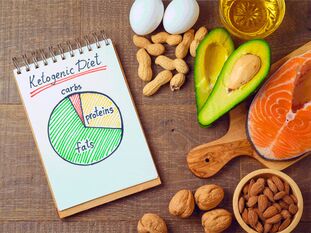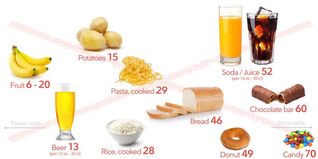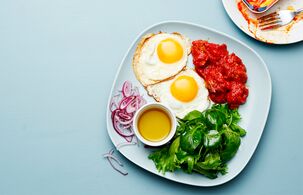
Fashion bloggers and glossy magazines everywhere are shouting about different ways to lose weight: a gluten-free diet, the Kremlin, fresh juices by blood type, and hundreds more. No matter how much you may argue about the effectiveness of each method, what’s the point if women’s main question remains “how to lose weight? ” Diet often has negative associations because it entails limitations and discomforts, but ketogenic nutrition is hard to attribute to them. The keto diet is a diet high in fat and protein, a diet low in carbohydrates.
How does it work?
Our bodies are designed to get energy from carbohydrates (glucose) for their work. An alternative source of energy is the breakdown of fats, or rather so-called ketone bodies. If your blood sugar is low (without carbs, this is unavoidable), fat reserves are used. By absorbing them as fuel for the body and brain, extra centimeters begin to leave.
Accordingly, the goal of a diet is to trigger a metabolic state in which the amount of carbohydrates in the diet is minimized and the amount of fat consumed is maximized.
Remember that every diet puts a strain on the body and the body. When choosing a way to lose weight, try to properly assess your health and fitness.
In 2016, the results of a study in which scientists and health professionals studied the effects of a low-carbohydrate diet on the body and risk factors for cardiovascular disease were published. They concluded that subjects on a low-carbohydrate diet lost significantly more than those who continued to consume carbohydrates. The second side of the coin was that weight loss was associated with an increase in cholesterol levels, which is not good for health.
There are now a number of techniques designed to reduce one of the indicators of the BJU. The leader of recent years can be called the Ducan diet - a protein nutrition system that consists of four stages. Which mode you prefer is up to you.
What is ketosis?
This is the state of the body when ketone bodies or ketones become the main source of energy. In order for the body to start working in this mode, you need to monitor your carbohydrate fasting for 3-4 days and then continue with one of the appropriate types of keto diet.
Types of Keto Diets
Classic.This is a low carb and low fat diet. In fact, the whole article is about the classic version, in which the ideal ratio of BJU is: 75% fat, 20% protein and 5% carbs.
Cyclic Keto Diet. In this case, it means an alternation of 5 days with strict adherence to the diet and an alternation of 2 days of the so-called "cheating meal", when 400-500 g of carbohydrates are allowed to be consumed per day, allowing the replenishment of glycogen stores.
This setting is most commonly used before or during increased and intense sports exposure. This diet speeds up metabolism, fat burning and lean muscle mass growth. Many nutritionists insist that the right diet is balanced, so this is one of the diet options listed.
Targeted keto diet.Suitable for professional athletes, most commonly used by bodybuilders. In this case, you should consume carbohydrates an hour and a half before starting the workout. This type of ketogenic diet allows you to replenish your glycogen stores so that you don’t indulge in exhaustion and at the same time get out of ketosis.
Positive and Negative Aspects of the Keto Diet
Benefits:
- With a ketogenic diet, there is no dramatic change in diet and artificial calorie reduction, which usually leads to weight gain and sometimes weight gain after weight loss.
- As a general rule, the feeling of hunger goes away and stamina increases.
- A keto diet can help you lose weight. This is why audiences often use them to prepare for urgent filming or major events.
- A low carb diet is often preferred by those with insulin resistance and metabolic syndrome because they see excellent results and a solution to chronic diseases. Reducing carbohydrates to a ketogen level of 25 to 50 grams per day will help keep insulin levels low and normal.
- The keto diet is also recommended as a drug-free treatment for difficult-to-control childhood epilepsy. This is evidenced by the 2016 research.
- Excess fat loss and improvement in the general condition of type 2 diabetics may be beneficial. This was reflected in a 2018 study abroad, in which 2, 5 thousand people participated. Some subjects had a low-carbohydrate diet, while others ate a more balanced diet. The focus of the study was on glycemic control. Through systematic observations, analyzes, and comparisons, the scientists concluded that the keto diet has a beneficial effect on the body and can be used as part of an individual monitoring plan under medical supervision.
Disadvantages:
- The most common side effects are constipation, mildly low blood sugar or upset stomach.
- Less commonly, a low carb diet can lead to kidney stones or increased acid levels in the body (acidosis).
- Other side effects may include "keto-flu, " which includes headache, chills, occasional fever, weakness, irritability, and bad breath.
- When your body burns fat stores, it strains your kidneys and also raises blood ammonia levels.
- Poor diet and imbalance. As carbohydrate intake is minimized, there are significant restrictions on food intake.
- Many people note that at first there is general weakness, lethargy and drowsiness in the body.
- Ketone bodies are quite toxic to the body, so it’s important not to lure your fate on your own and seek advice from a nutritionist or doctor who will monitor you as you lose weight.
Contraindications
Who should avoid the Keto diet?
- Patients with liver and kidney disease, high cholesterol and metabolic disorders.
- Diabetics should only experiment with nutrition under medical supervision.
- Pregnant and lactating women.
What to eat and drink on a keto diet? What foods can you eat?
Unprocessedmeat, ie salting, preserving, smoking, etc. without processes. Fatty parts of pork, lamb, beef, duck, chicken and turkey, bacon and lard are suitable. Refrain from sausages and sausages.
Fish and seafood. Salmon, salmon, saury, sardines, mackerel, herring and seafood are great. Avoid breading during cooking as it contains carbohydrates.
Eggs. Consume in any form: boiled, stuffed, fried in butter, scrambled eggs, etc.

Vegetables growing above the ground. Favorites include cauliflower, cucumber, asparagus, avocado, broccoli, spinach, green beans and zucchini. Say goodbye to root vegetables: potatoes, beets, onions, carrots, celery root, etc. Use olive oil or butter for cooking.
Dairy products: cottage cheese, butter, cheese, cream, sour cream. The main condition is that you have to be bold.
Nuts. Good for snacks other than cashews. It is better to exclude this type due to its high carbohydrate content.
Oils and fats.When talking about vegetable oils, we prefer olive oil. Coconuts are also very popular, which can significantly diversify the flavor palette of foods.
What should we drink?
During a keto diet, it is important to drink plenty of water, water helps get rid of toxins from the body.
A 2015 study found that replacing diet drinks with water after a main meal can lead to greater weight loss and improve insulin resistance.
Remove all soft drinks and juices, energy drinks and smoothies, and beer.
What to drink by the water? Unsweetened coffee and tea and wine are the least harmful in terms of carbohydrate content.
What foods should you avoid?
First of all, you have to gather all your will into a fist and give up what attracts you best: sweets, candies, cakes, cookies, chocolate, donuts and breakfast muesli. Sugar-free diets have long been popular with women around the world and eliminate simple carbohydrates and refined sweeteners that can help reduce the risk of heart disease.

Starchy foods: bread, pasta, rice, corn, potatoes, peas, chips, cereals, muesli and more. If you see the word "whole grain, " put the item back on the shelf.
Legumes, avoid beans and lentils first.
Don't drink milk and say goodbye to latte (contains 18 grams of carbs), avoid low-fat yogurt
Raspberries, strawberries, blueberries, watermelons and melons are the best choices for fruits and berries. Bananas, grapes, mangoes, pears, apples and kiwis can worsen carbohydrate statistics.
A smart man said that "losing weight without restricting food is tantamount to conquering laziness without getting up from the couch. "Expect to work hard and change your eating habits.
Example of a weekly keto menu
You need to love cooking to diversify your diet and achieve your goals. What can be the food of the week?
Monday
- Breakfast: scrambled eggs with ham, cheese and spinach.
- Lunch: chicken soup and vegetable salad with natural mayonnaise.
- Dinner: fried fish with vegetables (green beans and greens) and brown rice.
Tuesday
- Breakfast: grated cheese omelette and steamed fish cakes.
- Lunch: tuna salad with a mixture of avocado and lettuce leaves, flavored with olive oil or natural mayonnaise.
- Dinner: roasted meat with vegetables.
Wednesday
- Breakfast: boiled eggs and toast with cream cheese and avocado.
- Lunch: beetroot with meat.
- Dinner: sea salad and cauliflower pancakes.
Thursday:
- Breakfast: 2 eggs and asparagus fried in butter.
- Lunch: puree soup and vegetable salad.
- Dinner: Casserole with mushrooms.
Friday:
- Breakfast: smoked salmon and avocado sandwich.
- Lunch: fish soup.
- Dinner: frittata with fresh spinach.

Saturday
- Breakfast: omelette with mushrooms and cheese.
- Lunch: boiled chicken with hummus and salad.
- Dinner: cabbage salad and roast turkey with cream cheese sauce.
Sunday
- Breakfast: casserole with mushrooms.
- Lunch: chicken soup.
- Dinner: cut with avocado and green beans fried in butter.
Conclusion: how many people, so many methods to lose weight. A ketogenic diet is a short-term diet that focuses on weight loss rather than health benefits. The results of clinical trials investigating the effects of a ketogenic diet are contradictory and should be exercised for up to a few months and under medical supervision.






























